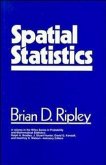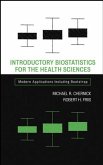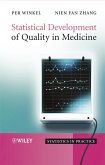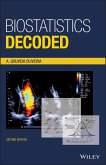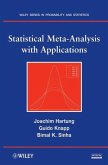Kung-Jong Lui
Statistical Estimation of Epidemiological Risk (eBook, PDF)
98,99 €
98,99 €
inkl. MwSt.
Sofort per Download lieferbar

0 °P sammeln
98,99 €
Als Download kaufen

98,99 €
inkl. MwSt.
Sofort per Download lieferbar

0 °P sammeln
Jetzt verschenken
Alle Infos zum eBook verschenken
98,99 €
inkl. MwSt.
Sofort per Download lieferbar
Alle Infos zum eBook verschenken

0 °P sammeln
Kung-Jong Lui
Statistical Estimation of Epidemiological Risk (eBook, PDF)
- Format: PDF
- Merkliste
- Auf die Merkliste
- Bewerten Bewerten
- Teilen
- Produkt teilen
- Produkterinnerung
- Produkterinnerung

Bitte loggen Sie sich zunächst in Ihr Kundenkonto ein oder registrieren Sie sich bei
bücher.de, um das eBook-Abo tolino select nutzen zu können.
Hier können Sie sich einloggen
Hier können Sie sich einloggen
Sie sind bereits eingeloggt. Klicken Sie auf 2. tolino select Abo, um fortzufahren.

Bitte loggen Sie sich zunächst in Ihr Kundenkonto ein oder registrieren Sie sich bei bücher.de, um das eBook-Abo tolino select nutzen zu können.
Statistical Estimation of Epidemiological Risk provides coverage of the most important epidemiological indices, and includes recent developments in the field. A useful reference source for biostatisticians and epidemiologists working in disease prevention, as the chapters are self-contained and feature numerous real examples. It has been written at a level suitable for public health professionals with a limited knowledge of statistics.
Other key features include:
Provides comprehensive coverage of the key epidemiological indices. | Includes coverage of various sampling methods, and…mehr
- Geräte: PC
- mit Kopierschutz
- eBook Hilfe
- Größe: 1.1MB
Andere Kunden interessierten sich auch für
![Spatial Statistics (eBook, PDF) Spatial Statistics (eBook, PDF)]() Brian D. RipleySpatial Statistics (eBook, PDF)131,99 €
Brian D. RipleySpatial Statistics (eBook, PDF)131,99 €![Introductory Biostatistics for the Health Sciences (eBook, PDF) Introductory Biostatistics for the Health Sciences (eBook, PDF)]() Michael R. ChernickIntroductory Biostatistics for the Health Sciences (eBook, PDF)160,99 €
Michael R. ChernickIntroductory Biostatistics for the Health Sciences (eBook, PDF)160,99 €![Statistical Development of Quality in Medicine (eBook, PDF) Statistical Development of Quality in Medicine (eBook, PDF)]() Per WinkelStatistical Development of Quality in Medicine (eBook, PDF)79,99 €
Per WinkelStatistical Development of Quality in Medicine (eBook, PDF)79,99 €![Biostatistical Methods in Epidemiology (eBook, PDF) Biostatistical Methods in Epidemiology (eBook, PDF)]() Stephen C. NewmanBiostatistical Methods in Epidemiology (eBook, PDF)171,99 €
Stephen C. NewmanBiostatistical Methods in Epidemiology (eBook, PDF)171,99 €![Biostatistics Decoded (eBook, PDF) Biostatistics Decoded (eBook, PDF)]() A. Gouveia OliveiraBiostatistics Decoded (eBook, PDF)105,99 €
A. Gouveia OliveiraBiostatistics Decoded (eBook, PDF)105,99 €![Statistical Meta-Analysis with Applications (eBook, PDF) Statistical Meta-Analysis with Applications (eBook, PDF)]() Joachim HartungStatistical Meta-Analysis with Applications (eBook, PDF)131,99 €
Joachim HartungStatistical Meta-Analysis with Applications (eBook, PDF)131,99 €![Biostatistics (eBook, PDF) Biostatistics (eBook, PDF)]() Gerald Van BelleBiostatistics (eBook, PDF)183,99 €
Gerald Van BelleBiostatistics (eBook, PDF)183,99 €-
-
-
Statistical Estimation of Epidemiological Risk provides coverage of the most important epidemiological indices, and includes recent developments in the field. A useful reference source for biostatisticians and epidemiologists working in disease prevention, as the chapters are self-contained and feature numerous real examples. It has been written at a level suitable for public health professionals with a limited knowledge of statistics.
Other key features include:
Other key features include:
- Provides comprehensive coverage of the key epidemiological indices.
- Includes coverage of various sampling methods, and pointers to where each should be used.
- Includes up-to-date references and recent developments in the field.
- Features many real examples, emphasising the practical nature of the book.
- Each chapter is self-contained, allowing the book to be used as a useful reference source.
- Includes exercises, enabling use as a course text.
Dieser Download kann aus rechtlichen Gründen nur mit Rechnungsadresse in D ausgeliefert werden.
Produktdetails
- Produktdetails
- Verlag: Wiley
- Erscheinungstermin: 2. April 2004
- Englisch
- ISBN-13: 9780470094075
- Artikelnr.: 37290433
- Verlag: Wiley
- Erscheinungstermin: 2. April 2004
- Englisch
- ISBN-13: 9780470094075
- Artikelnr.: 37290433
- Herstellerkennzeichnung Die Herstellerinformationen sind derzeit nicht verfügbar.
KUNG-JONG LUI is a professor in the Department of Mathematics and Statistics at San Diego State University. Since he obtained his Ph.D. in biostatistics from UCLA in 1982, he has published more than 100 papers in peer-reviewed journals, including Biometrics, Statistics in Medicine, Biometrical Journal, Psychometrika, Communications in Statistics: Theory and Methods, Science, Proceedings of National Academy of Sciences, Controlled Clinical Trials, Journal of Official Statistics, IEEE Transactions on Reliability, Environmetrics, Test, Computational Statistics and Data Analysis, American Journal of Epidemiology, American Journal of Public Health, etc. He is a Fellow of the American Statistical Association, a life member of the International Chinese Statistical Association, and a member of the Western North American Region of the International Biometric Society.
About the author.
Preface.
1 Population Proportion or Prevalence.
1.1 Binomial sampling.
1.2 Cluster sampling.
1.3 Inverse sampling.
Exercises.
References.
2 Risk Difference.
2.1 Independent binomial sampling.
2.2 A series of independent binomial sampling procedures.
2.2.1 Summary interval estimators.
2.2.2 Test for the homogeneity of risk difference.
2.3 Independent cluster sampling.
2.4 Paired-sample data.
2.5 Independent negative binomial sampling (inverse sampling).
2.6 Independent poisson sampling.
2.7 Stratified poisson sampling.
Exercises.
References.
3 Relative Difference.
3.1 Independent binomial sampling.
3.2 A series of independent binomial sampling procedures.
3.2.1 Asymptotic interval estimators.
3.2.2 Test for the homogeneity of relative difference.
3.3 Independent cluster sampling.
3.4 Paired-sample data.
3.5 Independent inverse sampling.
Exercises.
References.
4 Relative Risk.
4.1 Independent binomial sampling.
4.2 A series of independent binomial sampling procedures.
4.2.1 Asymptotic interval estimators.
4.2.2 Test for the homogeneity of risk ratio.
4.3 Independent cluster sampling.
4.4 Paired-sample data.
4.5 Independent inverse sampling.
4.5.1 Uniformly minimum variance unbiased estimator of relative risk.
4.5.2 Interval estimators of relative risk.
4.6 Independent poisson sampling.
4.7 Stratified poisson sampling.
Exercises.
References.
5 Odds Ratio.
5.1 Independent binomial sampling.
5.1.1 Asymptotic interval estimators.
5.1.2 Exact confidence interval.
5.2 A series of independent binomial sampling procedures.
5.2.1 Asymptotic interval estimators.
5.2.2 Exact confidence interval.
5.2.3 Test for homogeneity of the odds ratio.
5.3 Independent cluster sampling.
5.4 One-to-one matched sampling.
5.5 Logistic modeling.
5.5.1 Estimation under multinomial or independent binomial sampling.
5.5.2 Estimation in the case of paired-sample data.
5.6 Independent inverse sampling.
5.7 Negative multinomial sampling for paired-sample data.
Exercises.
References.
6 Generalized Odds Ratio.
6.1 Independent multinomial sampling.
6.2 Data with repeated measurements (or under cluster sampling).
6.3 Paired-sample data.
6.4 Mixed negative multinomial and multinomial sampling.
Exercises.
References.
7 Attributable Risk.
7.1 Study designs with no confounders.
7.1.1 Cross-sectional sampling.
7.1.2 Case-control studies.
7.2 Study designs with confounders.
7.2.1 Cross-sectional sampling.
7.2.2 Case-control studies.
7.3 Case-control studies with matched pairs.
7.4 Multiple levels of exposure in case-control studies.
7.5 Logistic modeling in case-control studies.
7.5.1 Logistic model containing only the exposure variables of interest.
7.5.2 Logistic regression model containing both exposure and confounding
variables.
7.6 Case-control studies under inverse sampling.
Exercises.
References.
8 Number Needed to Treat.
8.1 Independent binomial sampling.
8.2 A series of independent binomial sampling procedures.
8.3 Independent cluster sampling.
8.4 Paired-sample data.
Exercises.
References.
Appendix Maximum Likelihood Estimator and Large-Sample Theory.
A.1: The maximum likelihood estimator, Wald's test, the score test, and the
asymptotic likelihood ratio test.
A.2: The delta method and its applications.
References.
Answers to Selected Exercises.
Index.
Preface.
1 Population Proportion or Prevalence.
1.1 Binomial sampling.
1.2 Cluster sampling.
1.3 Inverse sampling.
Exercises.
References.
2 Risk Difference.
2.1 Independent binomial sampling.
2.2 A series of independent binomial sampling procedures.
2.2.1 Summary interval estimators.
2.2.2 Test for the homogeneity of risk difference.
2.3 Independent cluster sampling.
2.4 Paired-sample data.
2.5 Independent negative binomial sampling (inverse sampling).
2.6 Independent poisson sampling.
2.7 Stratified poisson sampling.
Exercises.
References.
3 Relative Difference.
3.1 Independent binomial sampling.
3.2 A series of independent binomial sampling procedures.
3.2.1 Asymptotic interval estimators.
3.2.2 Test for the homogeneity of relative difference.
3.3 Independent cluster sampling.
3.4 Paired-sample data.
3.5 Independent inverse sampling.
Exercises.
References.
4 Relative Risk.
4.1 Independent binomial sampling.
4.2 A series of independent binomial sampling procedures.
4.2.1 Asymptotic interval estimators.
4.2.2 Test for the homogeneity of risk ratio.
4.3 Independent cluster sampling.
4.4 Paired-sample data.
4.5 Independent inverse sampling.
4.5.1 Uniformly minimum variance unbiased estimator of relative risk.
4.5.2 Interval estimators of relative risk.
4.6 Independent poisson sampling.
4.7 Stratified poisson sampling.
Exercises.
References.
5 Odds Ratio.
5.1 Independent binomial sampling.
5.1.1 Asymptotic interval estimators.
5.1.2 Exact confidence interval.
5.2 A series of independent binomial sampling procedures.
5.2.1 Asymptotic interval estimators.
5.2.2 Exact confidence interval.
5.2.3 Test for homogeneity of the odds ratio.
5.3 Independent cluster sampling.
5.4 One-to-one matched sampling.
5.5 Logistic modeling.
5.5.1 Estimation under multinomial or independent binomial sampling.
5.5.2 Estimation in the case of paired-sample data.
5.6 Independent inverse sampling.
5.7 Negative multinomial sampling for paired-sample data.
Exercises.
References.
6 Generalized Odds Ratio.
6.1 Independent multinomial sampling.
6.2 Data with repeated measurements (or under cluster sampling).
6.3 Paired-sample data.
6.4 Mixed negative multinomial and multinomial sampling.
Exercises.
References.
7 Attributable Risk.
7.1 Study designs with no confounders.
7.1.1 Cross-sectional sampling.
7.1.2 Case-control studies.
7.2 Study designs with confounders.
7.2.1 Cross-sectional sampling.
7.2.2 Case-control studies.
7.3 Case-control studies with matched pairs.
7.4 Multiple levels of exposure in case-control studies.
7.5 Logistic modeling in case-control studies.
7.5.1 Logistic model containing only the exposure variables of interest.
7.5.2 Logistic regression model containing both exposure and confounding
variables.
7.6 Case-control studies under inverse sampling.
Exercises.
References.
8 Number Needed to Treat.
8.1 Independent binomial sampling.
8.2 A series of independent binomial sampling procedures.
8.3 Independent cluster sampling.
8.4 Paired-sample data.
Exercises.
References.
Appendix Maximum Likelihood Estimator and Large-Sample Theory.
A.1: The maximum likelihood estimator, Wald's test, the score test, and the
asymptotic likelihood ratio test.
A.2: The delta method and its applications.
References.
Answers to Selected Exercises.
Index.
About the author.
Preface.
1 Population Proportion or Prevalence.
1.1 Binomial sampling.
1.2 Cluster sampling.
1.3 Inverse sampling.
Exercises.
References.
2 Risk Difference.
2.1 Independent binomial sampling.
2.2 A series of independent binomial sampling procedures.
2.2.1 Summary interval estimators.
2.2.2 Test for the homogeneity of risk difference.
2.3 Independent cluster sampling.
2.4 Paired-sample data.
2.5 Independent negative binomial sampling (inverse sampling).
2.6 Independent poisson sampling.
2.7 Stratified poisson sampling.
Exercises.
References.
3 Relative Difference.
3.1 Independent binomial sampling.
3.2 A series of independent binomial sampling procedures.
3.2.1 Asymptotic interval estimators.
3.2.2 Test for the homogeneity of relative difference.
3.3 Independent cluster sampling.
3.4 Paired-sample data.
3.5 Independent inverse sampling.
Exercises.
References.
4 Relative Risk.
4.1 Independent binomial sampling.
4.2 A series of independent binomial sampling procedures.
4.2.1 Asymptotic interval estimators.
4.2.2 Test for the homogeneity of risk ratio.
4.3 Independent cluster sampling.
4.4 Paired-sample data.
4.5 Independent inverse sampling.
4.5.1 Uniformly minimum variance unbiased estimator of relative risk.
4.5.2 Interval estimators of relative risk.
4.6 Independent poisson sampling.
4.7 Stratified poisson sampling.
Exercises.
References.
5 Odds Ratio.
5.1 Independent binomial sampling.
5.1.1 Asymptotic interval estimators.
5.1.2 Exact confidence interval.
5.2 A series of independent binomial sampling procedures.
5.2.1 Asymptotic interval estimators.
5.2.2 Exact confidence interval.
5.2.3 Test for homogeneity of the odds ratio.
5.3 Independent cluster sampling.
5.4 One-to-one matched sampling.
5.5 Logistic modeling.
5.5.1 Estimation under multinomial or independent binomial sampling.
5.5.2 Estimation in the case of paired-sample data.
5.6 Independent inverse sampling.
5.7 Negative multinomial sampling for paired-sample data.
Exercises.
References.
6 Generalized Odds Ratio.
6.1 Independent multinomial sampling.
6.2 Data with repeated measurements (or under cluster sampling).
6.3 Paired-sample data.
6.4 Mixed negative multinomial and multinomial sampling.
Exercises.
References.
7 Attributable Risk.
7.1 Study designs with no confounders.
7.1.1 Cross-sectional sampling.
7.1.2 Case-control studies.
7.2 Study designs with confounders.
7.2.1 Cross-sectional sampling.
7.2.2 Case-control studies.
7.3 Case-control studies with matched pairs.
7.4 Multiple levels of exposure in case-control studies.
7.5 Logistic modeling in case-control studies.
7.5.1 Logistic model containing only the exposure variables of interest.
7.5.2 Logistic regression model containing both exposure and confounding
variables.
7.6 Case-control studies under inverse sampling.
Exercises.
References.
8 Number Needed to Treat.
8.1 Independent binomial sampling.
8.2 A series of independent binomial sampling procedures.
8.3 Independent cluster sampling.
8.4 Paired-sample data.
Exercises.
References.
Appendix Maximum Likelihood Estimator and Large-Sample Theory.
A.1: The maximum likelihood estimator, Wald's test, the score test, and the
asymptotic likelihood ratio test.
A.2: The delta method and its applications.
References.
Answers to Selected Exercises.
Index.
Preface.
1 Population Proportion or Prevalence.
1.1 Binomial sampling.
1.2 Cluster sampling.
1.3 Inverse sampling.
Exercises.
References.
2 Risk Difference.
2.1 Independent binomial sampling.
2.2 A series of independent binomial sampling procedures.
2.2.1 Summary interval estimators.
2.2.2 Test for the homogeneity of risk difference.
2.3 Independent cluster sampling.
2.4 Paired-sample data.
2.5 Independent negative binomial sampling (inverse sampling).
2.6 Independent poisson sampling.
2.7 Stratified poisson sampling.
Exercises.
References.
3 Relative Difference.
3.1 Independent binomial sampling.
3.2 A series of independent binomial sampling procedures.
3.2.1 Asymptotic interval estimators.
3.2.2 Test for the homogeneity of relative difference.
3.3 Independent cluster sampling.
3.4 Paired-sample data.
3.5 Independent inverse sampling.
Exercises.
References.
4 Relative Risk.
4.1 Independent binomial sampling.
4.2 A series of independent binomial sampling procedures.
4.2.1 Asymptotic interval estimators.
4.2.2 Test for the homogeneity of risk ratio.
4.3 Independent cluster sampling.
4.4 Paired-sample data.
4.5 Independent inverse sampling.
4.5.1 Uniformly minimum variance unbiased estimator of relative risk.
4.5.2 Interval estimators of relative risk.
4.6 Independent poisson sampling.
4.7 Stratified poisson sampling.
Exercises.
References.
5 Odds Ratio.
5.1 Independent binomial sampling.
5.1.1 Asymptotic interval estimators.
5.1.2 Exact confidence interval.
5.2 A series of independent binomial sampling procedures.
5.2.1 Asymptotic interval estimators.
5.2.2 Exact confidence interval.
5.2.3 Test for homogeneity of the odds ratio.
5.3 Independent cluster sampling.
5.4 One-to-one matched sampling.
5.5 Logistic modeling.
5.5.1 Estimation under multinomial or independent binomial sampling.
5.5.2 Estimation in the case of paired-sample data.
5.6 Independent inverse sampling.
5.7 Negative multinomial sampling for paired-sample data.
Exercises.
References.
6 Generalized Odds Ratio.
6.1 Independent multinomial sampling.
6.2 Data with repeated measurements (or under cluster sampling).
6.3 Paired-sample data.
6.4 Mixed negative multinomial and multinomial sampling.
Exercises.
References.
7 Attributable Risk.
7.1 Study designs with no confounders.
7.1.1 Cross-sectional sampling.
7.1.2 Case-control studies.
7.2 Study designs with confounders.
7.2.1 Cross-sectional sampling.
7.2.2 Case-control studies.
7.3 Case-control studies with matched pairs.
7.4 Multiple levels of exposure in case-control studies.
7.5 Logistic modeling in case-control studies.
7.5.1 Logistic model containing only the exposure variables of interest.
7.5.2 Logistic regression model containing both exposure and confounding
variables.
7.6 Case-control studies under inverse sampling.
Exercises.
References.
8 Number Needed to Treat.
8.1 Independent binomial sampling.
8.2 A series of independent binomial sampling procedures.
8.3 Independent cluster sampling.
8.4 Paired-sample data.
Exercises.
References.
Appendix Maximum Likelihood Estimator and Large-Sample Theory.
A.1: The maximum likelihood estimator, Wald's test, the score test, and the
asymptotic likelihood ratio test.
A.2: The delta method and its applications.
References.
Answers to Selected Exercises.
Index.

